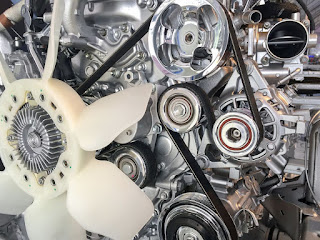That
working engine that propels your car has more to it. In order to move your car,
a number of additional components must cooperate. The drive belt is one
example of such a component. This essential but little-discussed car part,
if defective, can stop your car completely.
You
must be able to identify the signs of a defective auxiliary belt due to its
importance to the functioning of your car. Does the drive belt effect the
transmission is a question that needs an answer. The remainder of the post will
cover numerous topics related to auxiliary/drive belts, so you might want to
keep reading.
A
defective drive belt might show several symptoms. Therefore, you may act now to
prevent problems from getting worse if you recognise the symptoms of a worn
drive belt. The best course of action is to look online for car service near me
garages and have a dependable mechanic regularly check your
drive belt, belt tensioner, and engine components.
Symptoms of a Bad Drive Belt
Your
car may sustain extensive damage as a result of a defective drive belt.
Consequently, what occurs to a car when the belt snaps? numerous things. The
following are some of the more typical indications of a defective auxiliary
belt that you should watch out for and fix as soon as you can:
1.
Squealing Sounds - One of the more obvious
symptoms of a failing auxiliary/drive belt is the presence of squealing noises
in the vicinity of your car's front. This is frequently a sign that your belt
needs to be tightened and may be slipping. It might also happen after washing
the vehicle's underside. Typically, after a while, the squealing ceases. The
belt may, however, be broken if there is persistent screeching in the car's
engine area. You should hunt for car
repairs near me garages online and have it replaced before it
completely breaks. This loud screaming noise in this situation is especially
audible as the car climbs an incline. It is one of the indications of a
malfunctioning drive belt tensioner and is difficult to ignore.
2.
Steering issues - The drive belt is in
charge of the power steering system's operation if your car has variable assist
power steering. The power steering pump must be powered by the belt in order
for it to operate effectively. Smooth vehicle handling is challenging without
power steering. Before you can operate the vehicle, you have to fight with the
steering. Find car
maintenance near me garage online and request a trained mechanic
to conduct a thorough inspection if you suddenly notice your steering wheel is
heavy. There are numerous other potential problematic parts that could be the
cause.
3.
No Air Conditioning - The AC compressor is
driven by the auxiliary/drive belt, thus when the belt has a problem, your
car's air conditioning will suffer. That is not to suggest that when the AC is
turned on but no cool air is coming from the air vents, the auxiliary belt is
to blame. If the need arises, having your technician examine your belt is a
wonderful place to start.
4.
Overheating Engine - The water pump cools the
engine when it becomes too hot. An additional sign to watch out for is an
overheating engine because the drive belt also drives the water pump. The water
pump cannot pump the required amount of water to cool the engine when there is
an issue with the auxiliary/drive belt. If the engine is allowed to continue
operating without a functioning water pump, it will eventually start to
overheat and could become damaged. To prevent a potential complete engine
failure, find car
mechanics near me online
as soon as you notice an overheating engine and make an appointment as soon as
feasible.
5.
Damaged
Auxiliary/drive Belt - This is one of the visual cues that your belt needs
replacing. Any damage is a sign that the belt needs to be
replaced. Drive belts are robust and designed to operate constantly
for countless miles. The belt starts to show signs of wear and tear after a
while from running for such a long time. An auxiliary belt breaks as a
result of this wear and tear. This can be seen in the belt's rib wear,
abrasions, and cracked, broken ribs. Therefore, physically inspecting the belt
on your vehicle is an excellent approach to find out whether it's about to
break.

Comments
Post a Comment